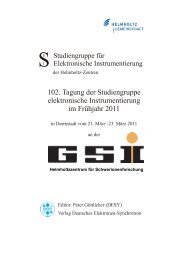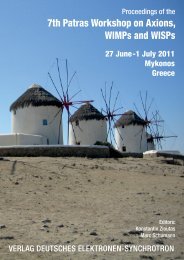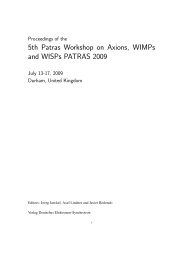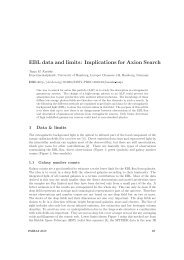Hamburg Neutrinos from Supernova Explosions ... - DESY Library
Hamburg Neutrinos from Supernova Explosions ... - DESY Library
Hamburg Neutrinos from Supernova Explosions ... - DESY Library
Create successful ePaper yourself
Turn your PDF publications into a flip-book with our unique Google optimized e-Paper software.
BERNHARD MÜLLER, HANS-THOMAS JANKA, ANDREAS MAREK, FLORIAN HANKE, . . .<br />
Figure 2: (color online) Explosion geometry for the GR simulations of the 11.2M⊙ (left panel,<br />
almost spherical shock) and the 15M⊙ progenitor (right panel, strong dipolar shock deformation)<br />
658 ms and 745 ms after bounce, respectively. The left and right half of the panels show<br />
the electron fraction Ye and the entropy s, respectively, and the shock is indicated as a white<br />
curve.<br />
tential” approach [28], which has long been the only means of including some GR corrections<br />
in multi-D neutrino hydrodynamics simulations. In addition, we also calculated a model with<br />
a simplified set of neutrino opacities (neglecting the effects of recoil, high-density correlations<br />
and weak magnetism in neutrino-nucleon reactions and ignoring reactions between different<br />
neutrino flavors), which serves to illustrate the importance of the neutrino microphysics for<br />
the dynamics in the supernova core and provides a scale of reference for the GR effects. As a<br />
marginal case close to the threshold between explosion and failure [6], the 15M⊙ progenitor is<br />
ideally suited for such a comparative analysis.<br />
Interestingly, we find that among the 15M⊙ models, the GR run with improved rates is<br />
the only one to develop an explosion with shock revival occurring some 450 ms after bounce<br />
(Fig. 1), indicating the relevance of both GR effects and of the neutrino microphysics. The<br />
different evolution of the three models with a different treatment of gravity is a consequence of<br />
the different compactness and surface temperature of the proto-neutron star, which leads to a<br />
clear hierarchy of the electron neutrino and antineutrino luminosities and mean energies (which<br />
determine the heating conditions) between the three cases (cp. [22, 29, 25] for this effect in 1D<br />
simulations) as illustrated by Fig. 1 for the electron antineutrinos, where the enhancement in<br />
GR is most pronounced. The beneficial effect of higher local heating rates as compared to the<br />
Newtonian case is, however, counterbalanced by the faster advection of material through the<br />
gain layer around a more compact proto-neutron star in the effective potential run, but in the<br />
GR case, the enhanced heating is strong enough to overcome this adverse effect.<br />
It is noteworthy that the neutrino emission and the shock evolution are similarly sensitive<br />
to the neutrino interaction rates (in agreement with the findings of [30, 7]). In the run with<br />
improved microphysics, weak magnetism and nucleon correlations lower the opacities for ¯νe,<br />
shift the neutrinosphere into deeper and hotter regions of the proto-neutron star surface [31],<br />
and thus result in harder ¯νe spectra (by up to ∼ 1 MeV during the late phases) and increased ¯νe<br />
16 HAνSE 2011<br />
3








